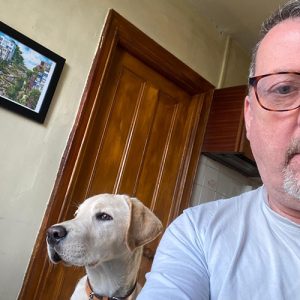If US support for UNAIDS permanently disappears, there will be millions more infections, and millions more deaths within just a few years, writes Terence Cosgrave
The US government – now controlled by Donald Trump and his Republican/MAGA party – have cut off the ‘river’ of funds to UNAIDS that they say was funding Hamas, terrorism and many other bad things. I haven’t seen any evidence for that, but I have seen evidence that the US administration is prepared to lie about many things, including the President’s signature on a birthday card. Either way, the river has been dammed.
The thing about a river is that it doesn’t ask your permission before it flows. It minds gravity and common sense. You dam it, the water piles up and goes around; you drain it, and all the things downstream turn into a cracked map of thirst. The UNAIDS partnership is a river like that, except the source isn’t snowmelt—it’s appropriations from governments. And, in January 2025, the men with the taps in Washington decided to twist the handle toward ‘off’ – pausing U.S. foreign assistance, including the lifelines that keep HIV treatment and prevention working in dozens of countries. Even a brief pause can do the work of a breach. Programs went slack. Shelves went bare. Clinics learned how loud a refrigerator hum sounds when there’s suddenly nothing inside it but hope.

Terence Cosgrave
By July, the alarm bells had gone from anxious to operatic. UNAIDS, the UN program that’s spent three decades herding the cats of science, logistics and politics together, published numbers that show that by the end of 2024, the world had managed to drive down new HIV infections by about 40 per cent since 2010, and AIDS-related deaths by about 56 per cent.
That was a victory you could taste. Then came the funding shock. If US support permanently disappears, UNAIDS’ models suggest millions more infections, and millions more deaths within just a few years—progress turned inside out like a pocket. Are we really going to let millions of people die needlessly?
This is the part where a narrator with a whiskey voice tells you that help is on the way and listen to the cavalry’s bugle. But the cavalry – being lawyers in this case – arrived with court filings. On September 4, a US federal judge told the Trump administration it could not simply keep the billions in foreign aid that Congress had already approved—a victory for the idea that budgets aren’t suggestions. Five days later, the US Supreme Court’s chief justice allowed a temporary freeze on a chunk of those funds while the appeals rolled on, which is the legal equivalent of tapping the brakes on a convoy halfway up the hill. If you’re a clinic director downriver, you don’t sigh in relief, you count how many weeks of antiretrovirals you can hand out before your shelves go to zero.
It is possible to call this ‘policy debate’. You can also call it triage by press release. In between the memos, UNAIDS officials said the quiet part out loud: take away the United States—the single biggest donor to the global HIV response—and you unravel the mathematics of prevention in places where international money buys most of the condoms, the tests, the outreach, the methadone, the clinic lights. International assistance pays for roughly four-fifths of HIV prevention in low and middle-income countries. Take that out and prevention starts to look like a lemonade stand with only lemons and no ‘ade’.
Here’s what it means:
- Treatment interruptions: When the US stops the money, countries relying on grants face procurement gaps. A gap isn’t an empty shelf; it’s a broken promise that echoes for years. Patients who miss doses risk viral rebound; viral rebound risks resistance; resistance costs more money, and more time than you have. This is how a hiccup becomes a cough becomes pneumonia.
- Prevention collapse: Prevention is a series of small habits funded by someone else’s taxes: testing, counselling, harm reduction, condoms at the clinic door, outreach at 10pm in the alley behind the bus station. It doesn’t fail spectacularly. It just quietly stops showing up. UNAIDS’ projections are explicit: sustained withdrawal could mean millions of additional infections within four to five years. Millions. Of. People.
- Maternal and child health: In 2024, children acquiring HIV from their mothers fell to the lowest number since the ‘80s—hard-fought progress that depends on routine testing, prophylaxis, and a reliable drug supply. Pull the thread and you don’t just lose a month, you risk a generation.
- Civil society damage: The local groups—the peer educators, the key-population networks, the volunteers who know which door to knock on—run on small grants and trust. Funding shocks tell them they’re optional. They are not.
Meanwhile, in a display of the kind of irony that would make a satirist whistle, the US also announced support to bring a shiny new HIV prevention drug—twice-yearly injections—’at cost’ to millions of people. It’s a fine idea, like delivering a brand-new fire engine to the station, and then taking the gasoline budget to Las Vegas. The medicine doesn’t move itself, the nurses don’t train themselves, the cold chain doesn’t hum on goodwill alone. Deliveries require the very funding streams the pause pulled taut.
But we’ve already seen that much of American government these days is conducted by unqualified people who don’t know what they’re doing, whether that’s obliterating Venezuelan citizens on the high seas, or arresting and chaining South Koreans in Georgia who are building factories to employ American workers.
Some of the fallout is psychological, which is a polite word for ‘demoralizing’. People living with HIV have a sixth sense for official indifference. They’ve heard plenty of speeches about sustainability and domestic resource mobilization, and they know a handoff when they feel one. Countries are trying to shoulder more of the load—that was the plan even before the shock—but a handoff implies somebody else still stands on the track to take the baton. Yanking away the funding mid-stride is not a handoff. It’s a tripwire.
Complicated things are generally made complicated by people who don’t have to live with them. The virus is not complicated. It wants to replicate. We know how to stop it. That’s the part that can drive you a little wild: the tools exist, the road map exists, the schools teach it, the clinics can do it, the ledger can show a line of zeros where there used to be funerals. When things fail, it’s not the science that quits. It’s the will, which is fickle, and the money, which goes wherever will tells it to go.
So what happens next? The US courts may force open part of the tap. Or not. The Trump administration may find ways to split the difference: fund some programs, starve others, keep everyone guessing until the guessing itself becomes policy. Bureaucracies are good at that; ambiguity is their native habitat. Even so, reality keeps a clipboard, and here are the realities to watch:
- Litigation whiplash: These recent decisions didn’t settle anything except the calendar. If you’re running a national HIV program, you don’t plan based on temporary stays – you plan for the worst and are grateful for surprises.
- Donor dominoes: When the biggest donor wobbles, others teeter. Some will try to fill the gap temporarily. ‘Temporarily’ is another word that can grow old fast. (Let’s all ride the Trump bandwagon!)
- Domestic financing: Countries will be told to ‘mobilize resources’, a phrase with the same energy as ‘clean your room,’ and about as successful without help. Some will step up. Others will be overwhelmed. The ones with the highest burdens are often the ones with the least fiscal space.
- Supply chain aftershocks: Even if the money returns, procurement cycles do not spring back like rubber; they slouch back like bureaucrats at 4:59pm. Backorders persist. Prices creep. Clinics re-open the cupboard to find the labels have changed and the training manuals haven’t.
- Stigma and criminalization: As money tightens, politics hardens. Programs serving sex workers, gay men, people who inject drugs—already soft targets—face the blade first. That’s a good way to turn a virus into a movement with a growth strategy.
There was a time when the American project abroad—the good part, anyway—looked like a schoolroom of practical idealists. Engineers with clipboards. Women juggling inventory lists and toddlers. Doctors who learned to say ‘how are you feeling’ in six languages. It wasn’t perfect; nothing run by humans is. But if you want to see the true character of a country, watch what it funds for strangers. The United States built something that worked. The world noticed. And then, the world noticed that the same country was willing to treat its own achievements like a lease that came due.
A final word about arithmetic, because arithmetic doesn’t care about our arguments: the present is a grace period extended by the past. The steady decline in deaths and infections up to 2024 didn’t happen because the virus cracked under cross-examination. It happened because people stocked little rooms with pills, day after day, in the right place, at the right time, for the right person, and they did it for years. That’s the ‘boring miracle’ public health people talk about when the microphones are off. It cannot tolerate long pauses. The virus will not wait politely for appropriations to reconstitute.
We know how to end AIDS as a public health threat. We already had the map; we were halfway down the road. Turn the tap, and the river remembers how to move. Leave it closed, and only there will be only dust to remember your neglect. ![]()










